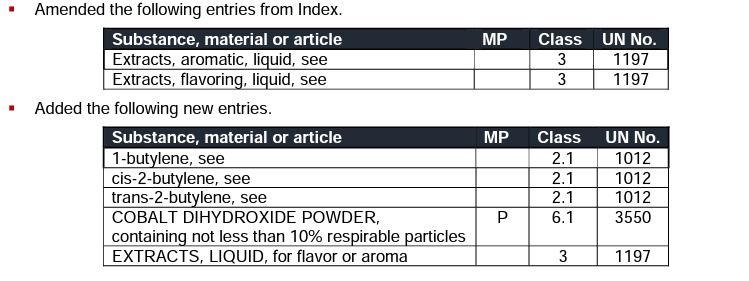The American Bureau of Shipping on 1 June 2023 published an article about the amendments to the International Maritime Dangerous Goods (IMDG) Code.
This article highlights amendments (41-22) to the International Maritime Dangerous Goods (IMDG) Code, bringing changes to storage and transfer procedures for dangerous goods.
Notable updates include revised testing and certification for aerosols, cylinders and pressure vessels, along with new provisions for portable shells made of fiber reinforced materials.
Ship owners should comply with the revised code for safe cargo transport.
Introduction
Resolution MSC.501(105) encompasses several amendments to the IMDG Code, aligning it with the revisions in the UN Recommendations on the Transport of Dangerous Goods, 21st Revised Edition.
These amendments, in addition to regular substance reviews, introduce key changes such as a new definition for "pressure receptacle shell" in 1.2.1 of the IMDG Code, guidance on marking refillable UN pressure receptacles and guidance on portable tanks utilizing fiber-reinforced plastic (FRP) shells.
Amendments (41-22) to the IMDG Code
Resolution MSC.501(105) was adopted on 28 April 2022, with entry into force on January 1, 2024. The Maritime Safety Committee also agreed that SOLAS contracting governments may apply the amended IMDG Code in whole or in part from January 1, 2023.
In addition to the regular review of new and existing substances, the primary changes included in the amendments were for the following:
Part 1 - General Provisions:
- Chapter 1.2: Several new definitions included to provide clarity to the descriptions and uses, such as new definitions for inner vessel and pressure receptacle shell.
Part 2 - Classification:
- New entries added for a “self-reactive” and three organic peroxides.
- Invitro test for skin classifications for corrosive exposure added under the section for the packaging group assignment for substances and mixtures.
- Added clarification for Chronic 1 and 2 marine pollutants classifications.
- Test summaries for lithium batteries requirements modified and do not apply to small button power cells already inside the equipment.
- Testing for “Low-dispersible radioactive material” updated.
Part 3 - Dangerous Goods List:
- New UN number “UN3550” provided for cobalt dihydroxide powder.
- Dangerous goods list amendments, such as the UN number "UN3208" changing the expected quantity code from E2 to E0 and "UN3209" from E0 to E2.
- Segregation Group UN2796 changed slightly from SGG1a to SGG1.
Part 4 - Tank and Packing Provisions:
- The packing instructions for P003, P004, P005, P006, P130, P144, P408, P801, P903, P906, P907, P909, and P910 received notes that the 400 kg limit does not apply when shipped in overpacks and non-specification packaging.
- Packing instruction P920 specifically addresses packaging for mixtures of fluorine and nitrogen.
- Water capacity updated from 1,000 to 3,000 liters.
Part 5 - Consignment Procedures:
- Clarifies labeling requirements on overpacks of radioactive material. Labels must be on both sides.
- The requirement for showing the telephone number on the lithium battery has been removed. However, this may continue to be applied until 31 December 2023.
- Labeling requirements for temperature-controlled substances and stabilized substances were added. Where applicable, the words “TEMPERATURE CONTROLLED” and "stabilized" must be printed on the corresponding containers.
Part 6 - Package Testing and Construction:
- Major change related to chapter 6 includes a new section 6.10 as related to the “Provisions for design, construction, inspection and testing of portable shells made of fiber reinforced (FRP) materials”.
- Several ISO standards for pressure vessels have been added.
- Inspection requirements for new pressure receptacles have been updated.
- Changes made to the frequency of periodic inspections of existing pressure receptacles.
- Deletion of ‘special stowage’ from note 1 in 7.2.7.1.4 as it is no longer applicable.
- Introduced new requirements related to construction and testing of IBC’s, MEEGC’s, and road tank vehicles.
Part 7 - Provisions Concerning Transport Operations:
- In the Index, deleted the entry for “Iron Powder”.

Revised Circulars
Revised recommendations on the safe use of pesticides in ships applicable to the fumigation of cargo transport units (MSC.1/Circ.1361/Rev.1 Dated 28 April 2022)
This circular supersedes the previous one, reference MSC.1/Circ. 1361.
- Placarding size was increased, including requirements to be readable after 3 months.
- Removed reference for optional "other" marking for fumigated cargoes.
Revised Emergency Response Procedures for Ships carrying dangerous goods (EmS Guide) (MSC.1/Circ.1588/Rev.2 dated 24 May 2022)
This circular supersedes the previous one, reference MSC.1/Circ.1588/Rev 1.
- This revision considers the amendments to the IMDG code 41-22.
- The purpose of this Guide is to provide guidance for dealing with fires and spillages (leakages) on board ships involving the dangerous goods listed in the IMDG Code.
- Various changes to schedules in the index.
Voluntary early implementation of revised IMDG Code
Voluntary compliance from January 1, 2023, relevant information:
- Bahamas Maritime Authority Technical Alert 23-05 – BMA Voluntary early implementation of revised IMDG Code. The Bahamas has advised its early acceptance of the amended IMDG Code.
- Other flag administrations may authorize early implementation upon request.










Related News
USCG issues safety alert on hazardous zone marking and awareness
Jan 21, 2025
USCG issues alert on improving vessel maneuvering systems to prevent accidents
Jan 20, 2025
Updated IMO guidelines for GMDSS radio installations on SOLAS ships
Jan 17, 2025